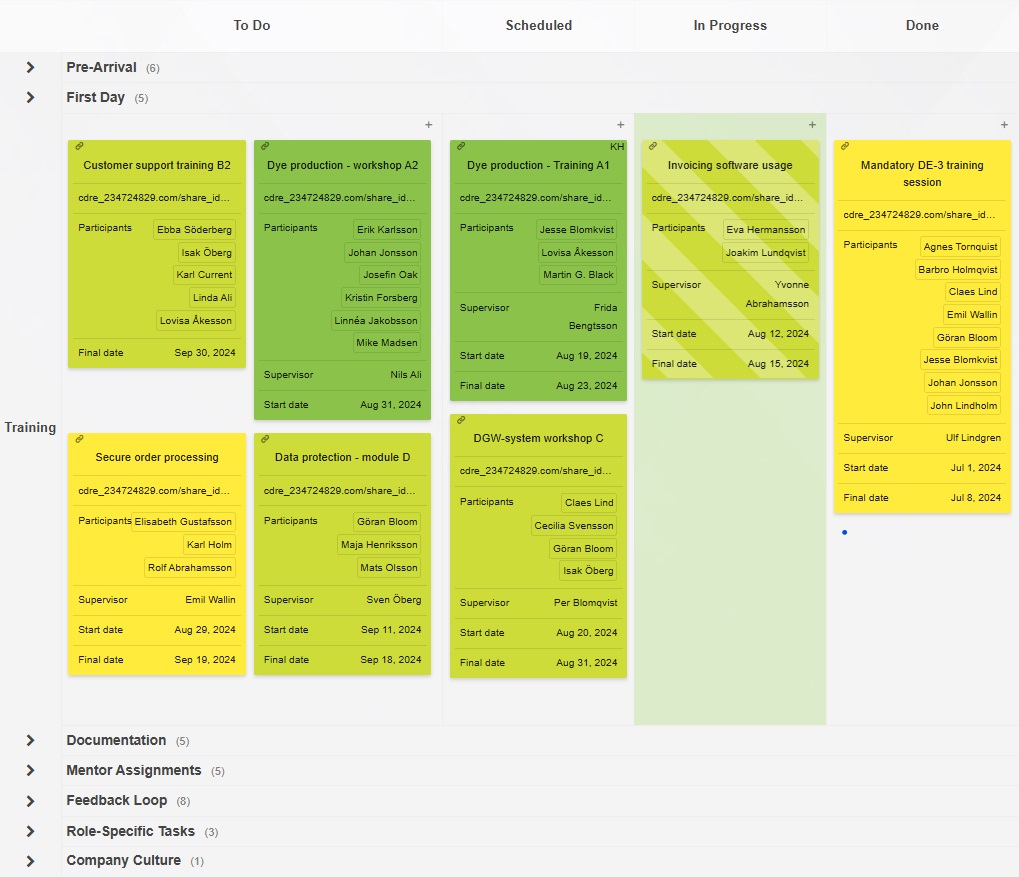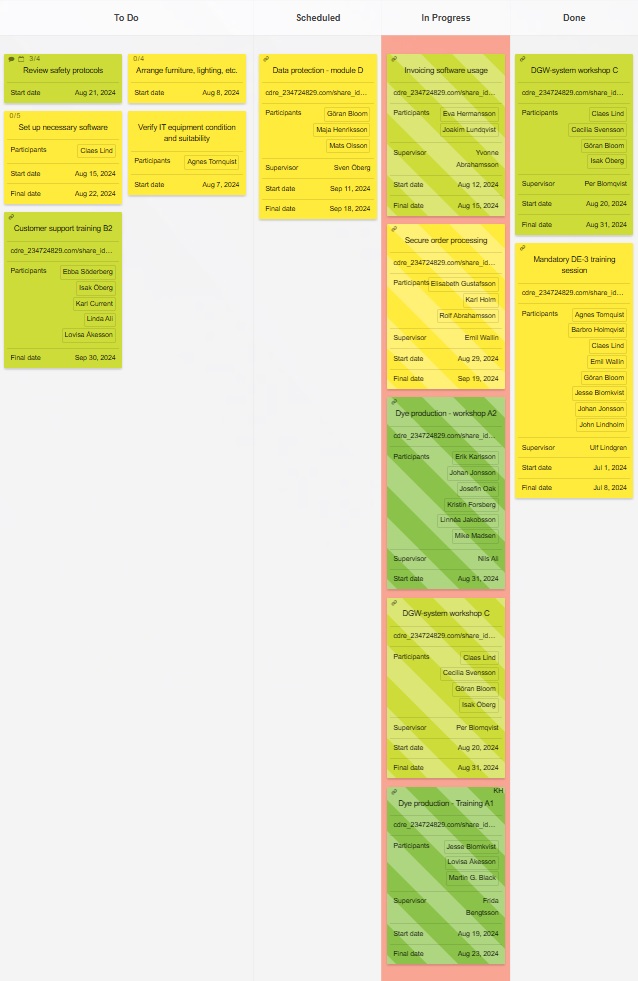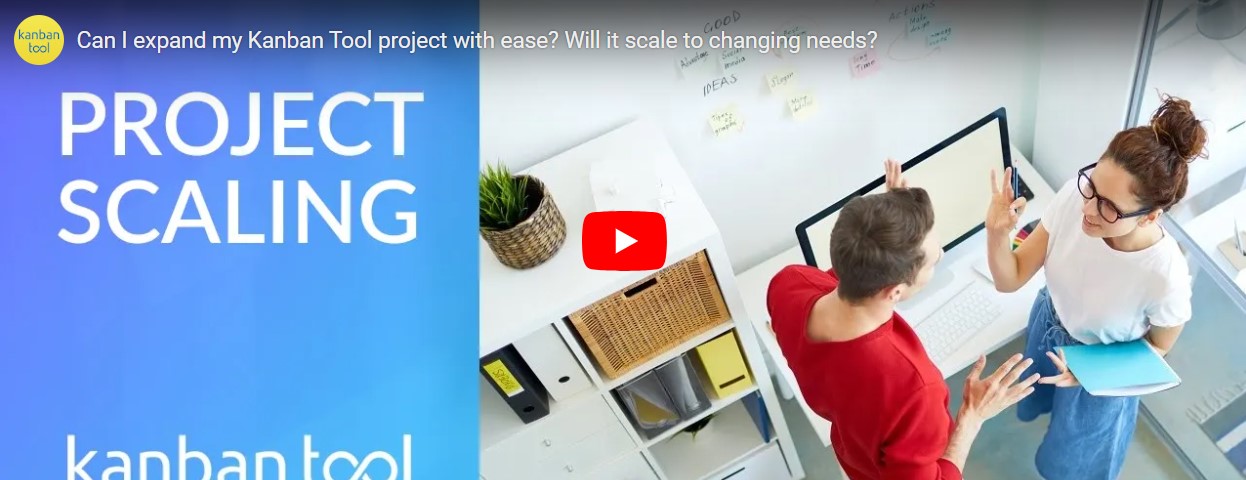Blog
Using Kanban Boards to Streamline Employee Skill Development and Training Programs14 Aug 2024

Continuous skill development is critical for your company's bottom line, employee retention, and business flexibility. As a forward-thinking organization, you should strive to keep your workforce competitive, engaged, and aligned with evolving industry demands. However, planning and managing employee training programs can be complex and overwhelming. That is where customizable Kanban boards might come into play, offering a streamlined, visual approach to tracking and improving skill development initiatives.
In this blog post, we explore how Kanban boards can transform your approach to employee development, driving higher efficiency, transparency, and engagement.
Bring clarity to training through visualization
One of the core aspects of Kanban boards is their ability to visualize the progress of training programs in real-time. Dividing a board into columns such as Planned, In Progress, Completed, and Reviewed allows you to map each employee’s journey through these stages, allowing managers and team members to see, at a glance, where they stand in their development path.

This visualization is not just about tracking progress - it’s about clarity. With everyone in the organization seeing who is working on what, which skills are getting developed, and where potential roadblocks exist, making informed decisions and adjustments gets easier. For instance, if a critical skill lags in development, managers can quickly identify the issue and take corrective action before it impacts overall performance.
Tailor the board to your needs through flexibility
No two organizations are alike, and neither are their training needs. Kanban boards offer the flexibility of being customized according to your business's unique requirements. Whether tracking individual employee development, team-wide training, or company-wide skill-building initiatives, the Kanban board can be tailored to fit your goals.
If your organization had an initiative to e.g., enhance leadership skills, you might create a separate column, swimlane, or a dedicated board to track progress. Each task within the workflow can align with specific learning objectives or milestones and have a set timeline. Combining all those details on the board would allow you to track progress and remain aligned with your strategic vision.
Keep the focus on what matters through workflow management
One of the key challenges in managing training programs is prioritizing the most critical skills. With Kanban boards, you can easily prioritize tasks based on urgency, importance, or individual career goals. Visually organizing tasks in a manner suitable for your organization helps you ensure optimal resource allocation.
For instance, if your organization is preparing for a major technological shift, the Kanban board can be used to prioritize training in new software or systems. Employees can then focus on these high-priority tasks, getting prepared for the upcoming changes in time. Moreover, by managing the flow of tasks through the board, you can prevent bottlenecks and avoid overwhelming employees with too many simultaneous learning objectives.

Keep the momentum going through bottleneck identification
Kanban boards are not just about tracking what’s moving forward; they’re also about identifying what isn't. For instance, tasks consistently getting stuck at In Progress, would be a clear signal that something isn’t working as planned. Perhaps employees are struggling with the material, or maybe there’s a lack of resources or support.
By identifying such bottlenecks early, managers can intervene and provide the necessary assistance to keep the training program on track. Whether it’s reallocating resources, offering help, or adjusting timelines, Kanban boards provide the insights needed to keep the momentum going.

Adapt in real time through continuous feedback
In a dynamic environment, the ability to adapt quickly is pivotal. Kanban boards facilitate continuous feedback loops, allowing for real-time adjustments to training programs. As tasks move across the board, managers can provide immediate feedback, helping employees stay on course and adapt as needed.
Such ongoing feedback is not just about correction but also about learning and growth. Employees are empowered to take ownership of their development, seeking guidance when needed and adjusting their learning strategies. It creates a more responsive and adaptive training environment in which the organization and its employees continuously get better.
Foster a culture of learning through accountability and collaboration
Kanban boards are inherently collaborative tools. By making everyone’s progress visible, they encourage team members to collaborate, share insights, and support each other’s development. It has the potential to foster a culture of learning, where ongoing improvement is a shared responsibility.
Moreover, the visibility provided by Kanban boards promotes accountability. When tasks and responsibilities are assigned and tracked, employees stand a higher chance of staying engaged and committed to their development goals. However, this accountability is not about micromanagement but rather about ensuring that everyone is working towards the same objectives and that progress is happening.
Leverage data-driven insights for future success
Over time, the data collected from Kanban boards becomes a valuable resource. By analyzing trends — such as which skills take longer to develop or which training programs yield the most results — your organization can make more informed decisions about future training.
For example, if the data shows that certain skills consistently face delays, it might indicate a need for more targeted training resources or a different instructional approach. Conversely, if some programs are particularly effective, perhaps they could be expanded or adapted for other areas of the organization. This data-driven approach ensures that training programs are effective and aligned with the organization’s long-term goals.

Celebrate progress for motivation and engagement
If you've ever used a Kanban board, you'll know that moving tasks from To Do to Completed is a powerful motivator. This aspect of Kanban boards provides employees with a tangible sense of progress, helping them see the impact of their efforts, boosting morale, and encouraging continued participation in skill development programs.
Celebrating these small wins — whether they are completing a challenging module or mastering a brand new skill — can impact employee engagement, as well as their relationship with the company. It also reinforces the belief that learning and development are integral to personal and organizational success.
Grow with your organization through easy scaling
Your employee training requirements grow alongside the company itself. One of the core advantages of Kanban boards is their scalability. Whether you’re tracking a small team’s development or managing a company-wide training initiative, Kanban boards can easily adjust to meet present needs.

As new skills become necessary, as additional employees join the organization, you can expand your Kanban boards to accommodate those changes. This scalability ensures that the training programs can grow alongside your business, remaining potent and relevant as the company evolves.
Summary
Kanban boards are more than just a means of managing tasks; they are a powerful framework for driving employee skill development and training programs. By providing clarity, flexibility, and continuous feedback, Kanban project boards help organizations stay competitive and adaptive in a fluid business landscape.
Implementing Kanban boards for your company's training programs can lead to more efficient workflows, better resource allocation, and a stronger, more skilled workforce. Whether you’re a small startup or a corporation, Kanban boards can provide the structure and insights needed to foster a culture of continuous learning and development.
Consider incorporating Kanban into your training strategy today, to see your organization’s skill development efforts become more organized, effective, and impactful. To make the adaptation quick and easy, use a kanbantool.com board for the project.
Curious about an example of using the Kanban Tool for both HR management and employee training programs management? Take a look at this use case video:

Sign up for a 14-day free trial
to test all the features.
Sign up now and see how we can help
your organization deliver exceptional results.